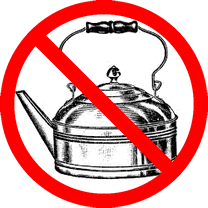
I discovered last night that although there is a French word for kettle – bouilloire – kettles are not common in French kitchens. More or less every kitchen in the UK, and Ireland, has a kettle, and a toaster (grille-pain) – they are considered essential equipment. However, according to a friend who used to live in France, French kitchens generally don’t have kettles, or toasters. Teapots are probably rare as well.
Is this true? What other things are normally found in kitchens where you live?
So even though there may be a word for something in another language, it might not be commonly-used (either the word or the thing it describes).
Here’s a tune I wrote called The Kettle / Y Tecell:
An electric rice cooker is considered an essential piece of equipment in any Chinese kitchen. A friend of mine, born in London to Chinese parents, just could not understand why I would choose to cook rice in a saucepan.
Yes the comparative absence of the kettle from French life is indeed a cultural difference. It causes some misunderstandings when UK tourists stay in French hotels and feel the absence of said equipment is a sign of poor accommodation, maybe even a source of complaint as in “they didn’t even provide tea making facilities”. Likewise the absence in France of those twee little packs of biscuits.
No proper Dutch kitchen without a kaasschaaf.
I can’t grasp a kitchen without a kettle. I mean, how do they drink tea? 😛
We do have kettles and toasters everywhere … I couldn’t live without them.
And tons of fancy teapots. But then maybe I’m a fake french (it is even highly possible).
For me as a Polish person, a kettle and a teapot are indispensable kitchen equipment. However, I lived in the southern US with a family for whom tea was only “ice tea” and coming in a bottle from a supermarket. They seemed to theoretically understand tea bags (they did not have any in the house), but brewing tea from loose leaves – absolutely not.
In Brazil (actually, in São Paulo — there are too many cultural differences inside Brazil and I cannot speak for the other 26 states at all), kettles are common, but not vital; most paulistas do not brew tea. It is however omnipresent at the countryside, where most people tend not to use moka pots and electric coffee brewers, resorting to the good old kettle, teapot, funnel and cloth or melitta filter. Coffee is indeed essential: the aforementioned moka pots and electric coffee brewers are basic culinary items in metropolitan houses. Espresso machines, although, are uncommon at home, and are mostly found at cafeterias and stores alike, while brewed coffee is only found at the average home and the padarias (a blend of bar, snack bar, bakery and highly-priced, low-quality grocery store where people mostly go to have a cheap, tasty, traditional breakfast (in São Paulo, grilled buttered French bread and latte) and to buy French bread, the brazilian bread of choice). A tool highly common in brazilian households is the pressure cooker (panela de pressão in Portuguese, which roughly translates to pressure pan), where people prepare beans, feijoada (if you don’t know what it is, look up its page at Wikipedia) and carne de panela (low quality bovine meat with loads of vegetables, pressure cooked until really soft), amongst other dishes. Food processors are uncommon, but not as rare as electric rice cookers (I believe I’ve seen more households with woks than with electric rice cookers), yet rice is part of the average brazilian’s daily diet (rice, beans, steak or fried eggs or both, lettuce and tomatoes).
Aside all of that, during a trip to the state of Espírito Santo I’ve learned that the average capixaba (demonym for Espírito Santo) household owns a clay pan, used to cook fish and other things.
Long comment is long.
I forgot to mention — the majority of the few people in São Paulo who drink tea use teabags bought from the supermarkets. Instead of kettles, leiteiras are more popular devices to boil water and, more commonly, milk — these are present in every house.
Another thing I forgot to mention (egads, this is getting awfully long) are the now forgotten sanduicheiras (this word is now used for electric presses used to grill sandwiches, but until the mid-2000’s they meant THIS (if you can’t quite understand how it works, here you go a sanduicheira making a regular bread sandwich). Nothing compares to the taste of the sandwiches made there *nostalgic sigh*)